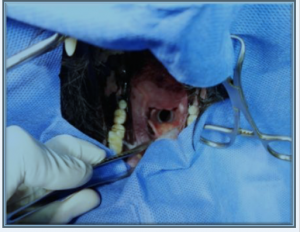Vet Reports
USE OF LARYNGEAL STENT IN CANINE IN CRISIS RESPIRATORY. REPORT OF A CASE
Date: 17-09-2020
Professional Applicant:
1 Fernández, Viviana *; 2 Hall, Pablo; 1 De Armas, Silvana; 1 Kuc, Enrique; 1 Fischman, Florence; 3 Ricart, María Cecilia.
1 University of Buenos Aires, Faculty of Veterinary Sciences, Concurrent Service of Anesthesiology and Algiology; 2 University of Buenos Aires, Faculty of Veterinary Sciences, Chair of Surgery; 3 University of Buenos Aires, Faculty of Veterinary Sciences, Chair of Small Animal Medical Clinic
Devices: ST 15-40 Stening ®
REPORT OF A CASE:
Introduction: Laryngeal paralysis (LP) is a frequent pathology in large dogslarge, elderly; it can be idiopathic or be a consequence of other pathologiesbase. In general, LP is not diagnosed until the moment of a respiratory crisisacute and severe.
Objective: This report sought to communicate a clinical case in which alaryngeal stent as a treatment for laryngeal paralysis in a dog and that its useallowed for subsequent surgical procedures.
Description : Female canine, neutered, 8 years old, 32 Kg weight, schnauzergiant, was presented to the surgery service of the Hospital Escuela de la Facultad de CienciasVeterinarians of the University of Buenos Aires for phalanx ablation in limbpelvic due to a neoformation with cytological diagnosis of cell carcinomaflaky. Fifteen days prior to the intervention date, she presented to the service withshortness of breath The clinical examination revealed alert sensory, anxious face,pale mucosa, capillary filling time not assessable, respiratory rate 60movements / minute, heart rate 140 beats / minute, strong pulse, temperature39.2 ° C, marked inspiratory dyspnea. Suspecting LP, sedation was performed(propofol 3mg / kg EV) for laryngoscopy per os. When confirming the diagnosis, it was consideredthe placement of the stent as a therapy and according to evolution, reprogram the surgery ofablation.
Pre-oxygenation of the animal was performed,administered propofol 3mg / kg IV and astent, (ST 15-40 Stening ®) without complications.He recovered from the procedure effortlesslyrespiratory nor stridor.
Due to good tolerance and evolution,scheduled phalanx surgery 15 days laterof the prosthesis placement, there were nocomplications when intubating the stentpositioned in the larynx, using an endo-tracheal No. 6.5 (smaller than the corresponding size for the patient, but without presentingleaks after pneumobulation, or changes in the position of the prosthesis). Withthe prosthesis placed as the only treatment for LP the patient had a survival14 months (died from other causes).The histopathological diagnosis of the tumor wassquamous cell carcinoma.
Conclusion : The laryngeal stent could be atherapeutic alternative for LP. Until theknowledge of the authors this would be the firstcase report of intubation throughlaryngeal prosthesis for scheduled surgery indog.Visualization of the stent in the laryngeal Visualization of the endotracheal tube within the stent laryngeal
Vet. Ma. Cecilia Ricart
Fernández, Viviana ; Hall, Pablo; De Armas, Silvana; Kuc, Enrique; Fischman, Florence
- Stening® Vet: Endoscopy UMA
Veterinary Endoscopy
Vet. María Cecilia Ricart
15.5837.9215
Date: 17-05-2018
Professional Applicant: Dr. Hall, Pablo
Owner: Milani, Alejandra
Patient:
Name: UMA Specie: Canino Breed: Labrador Gender: female Years: 10 years y 10 month
Study Done: Laryngo-tracheobronchoscopy
Practice made: placement of laryngeal prosthesis.
Study report:
Laryngoscopy:
Mobility: laryngeal paralysis (this was evaluated with a laryngoscope with the minimum anaesthetic plane in which the inspection was achieved).
Structure: preserved aritenoid cartilage. Exuberant scarring in the vocal cord area (chordectomy performed approximately 1 month and a half ago). Subglottic stenosis.
Tracheobronchoscopy: Slight hyperemia of the tracheal mucosa is observed along its entire length. Carina normal. Extrinsic dorsal compression of the left cranial bronchus compressing approximately 25% of the lumen. With the consent of the family and the referring colleague, a siliconized prosthesis is placed on cords. It is explained that it is an experimental procedure, the possible complications expected to the therapy are explained; the family agrees, understanding the risks. The patient recovers without immediate complications: no stridor is perceived.
Some pictures are attached:
Healing
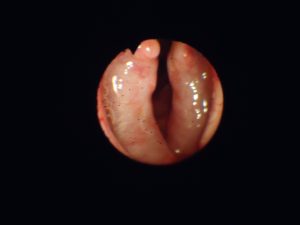
Carina
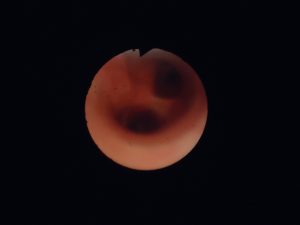
Left cranial bronchus
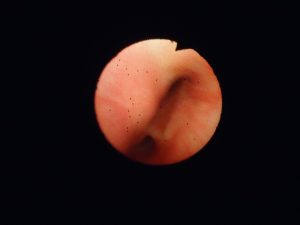
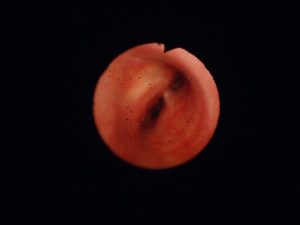
Stent in place
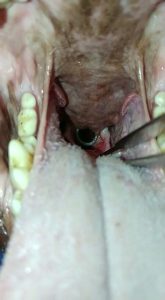
Vet. Ma. Cecilia Ricart
M.N. 8659
- Stening® Vet: smooth surface tumor
Gentileza Dr. Cesar Rojas
- Stening® Vet: report of a case
Resume
Laryngeal paralysis is the inability of the muscles to abduct the arytenoid cartilages during inspiration. In dogs the most frequent presentation is acquired, it is more prevalent in large and giant breeds with an average age of 9-10 years. The etiology usually remains hidden. The traditional treatment is surgical and its objective is to increase the opening of the glottis.
A therapeutic alternative is presented with the placement of a closed siliconized laryngeal prosthesis (stent) in a dog. Presentation of the case: Canine, Siberian Husky, male, 12 years old, presented for consultation at the Hospital Escuela, for episodes of respiratory difficulty in situations of stress or effort and changes in phonation. At the general and particular objective examination, an inspiratory stridor was found as the only abnormality. Laryngeal paralysis was suspected and confirmed by laryngoscopy. At the request of the owners to avoid surgery, an experimental alternative was performed on canines (a technique similar to that used in laryngeal pathologies in humans) by placing a closed silicone prosthesis.

